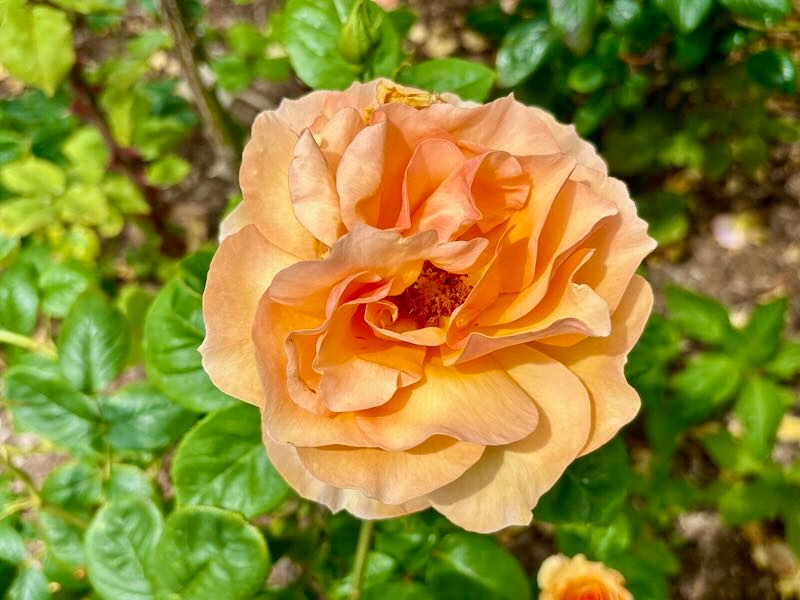Copper & Honey: Grow Rosa ‘Norwich Castle’ for Warm, Repeat Blooms
Rosa ‘Norwich Castle’ is a charming floribunda rose that delights gardeners with clusters of soft pink flowers and a reliable blooming season. Belonging to the family Rosaceae, this rose combines classic elegance with a practical growth habit, making it a standout choice for home gardens, borders, and rose collections. As a floribunda, it produces abundant blooms from late spring through autumn, offering a long season of color and fragrance. Gardeners often treasure ‘Norwich Castle’ for its balance of ornamental value and ease of care, which makes it accessible even to those new to growing roses.
The Appeal of Rosa ‘Norwich Castle’
Gardeners admire Rosa ‘Norwich Castle’ for its well-rounded qualities. The floribunda group is known for prolific flowering, and this variety lives up to that reputation. Its blooms form in clusters, ensuring that each stem carries more than one flower and extends the display. The blossoms are soft pink with a classic rose form, and they release a gentle fragrance that adds to their charm. Unlike many roses that demand constant attention, ‘Norwich Castle’ maintains a dependable growth habit and responds well to routine pruning and feeding.
This rose also adapts well to different garden styles. You can plant it in a traditional rose bed, use it as a focal point in a mixed border, or even grow it in a large container where its blooms will brighten patios and balconies. Because it repeats its blooms, it becomes a reliable centerpiece in any garden setting.
Common Names and Recognition
In addition to its cultivar name, gardeners sometimes refer to this rose simply as Norwich Castle Rose. Including both the formal and informal names helps when identifying plants at nurseries or when searching for care advice online. The name also honors the historic Norwich Castle in England, adding a sense of heritage and character to the rose.
Growth Habit and Size
Rosa ‘Norwich Castle’ typically grows as a medium-sized shrub. It reaches about 90 to 120 centimeters (3 to 4 feet) in height and spreads to a similar width. The growth habit is bushy but not overly dense, allowing good air circulation through the foliage. The dark green, glossy leaves provide a striking backdrop to the pastel blooms. The upright and rounded form makes it versatile in landscape design, as it fits neatly among perennials, shrubs, or other roses.
Flowering Season and Visual Appeal
This floribunda rose begins flowering in late spring and continues until the first frosts of autumn. Each flush of blooms lasts several weeks, and regular deadheading encourages more flowers to form. The color stays consistent throughout the season, with petals opening in shades of soft pink and sometimes showing a slightly deeper blush at the edges. The fragrance is light but noticeable, perfect for adding a touch of romance without overwhelming nearby plants.
Environmental Tolerance
Gardeners value Rosa ‘Norwich Castle’ for its adaptability. It grows well in temperate climates and tolerates a range of soil types when given good drainage. While it prefers full sun, it can also perform in partial sun, though the bloom count may decrease slightly. Its resilience to common conditions makes it a rewarding rose for urban gardens, cottage-style plantings, and even smaller yards where space is limited.
How to Grow Rosa ‘Norwich Castle’
Successful rose gardening depends on matching the plant’s needs with proper care. Rosa ‘Norwich Castle’ thrives when you give attention to light, soil, water, and nutrients.
Light
Plant Rosa ‘Norwich Castle’ where it receives at least six hours of direct sun each day. Full sun produces the strongest growth and the most abundant flowers. In partial shade, the plant will survive, but expect fewer blooms and less vigor. Position it away from heavy shade cast by large trees or tall buildings.
Soil
This rose prefers rich, well-drained soil. Incorporate organic matter such as compost or aged manure before planting to improve fertility and structure. Aim for a soil pH between 6.0 and 6.5, which suits most roses. Avoid planting in areas prone to waterlogging, as soggy soil can damage the roots.
Watering
Water deeply to encourage strong root development. Provide about 2.5 centimeters (1 inch) of water weekly during the growing season, adjusting for rainfall. Morning watering is best, as it allows foliage to dry during the day and reduces the risk of fungal diseases. Mulching around the base helps retain soil moisture and keeps roots cool.
Fertilizing
Feed Rosa ‘Norwich Castle’ with a balanced rose fertilizer. Apply the first dose in early spring as new growth appears. Continue feeding every 4 to 6 weeks until midsummer. Stop fertilizing by late summer to allow the plant to prepare for winter. Regular feeding encourages lush foliage and continuous flower production.
Pruning
Prune in late winter or very early spring before new growth emerges. Remove dead or weak stems, and cut back healthy canes by about one-third to encourage a compact shape and vigorous growth. Deadhead spent flowers throughout the season to stimulate new blooms and maintain a tidy appearance.
Propagation
You can propagate Rosa ‘Norwich Castle’ through hardwood or semi-ripe cuttings. Take cuttings about 15 to 20 centimeters (6 to 8 inches) long and plant them in a mixture of sand and compost. Keep them in a sheltered spot until roots form. Propagation allows you to create new plants that remain true to the original cultivar.
Pests and Diseases
Like most roses, Rosa ‘Norwich Castle’ can face pests such as aphids, thrips, and spider mites. You can manage infestations with a strong water spray, insecticidal soap, or horticultural oil. Diseases such as black spot, powdery mildew, and rust may occur if conditions remain damp or air circulation is poor. Prevent problems by watering at the base, spacing plants well, and pruning to keep the center of the shrub open. If needed, apply a fungicide labeled for roses.
Landscape Uses of Rosa ‘Norwich Castle’
This rose excels in many landscape roles. Use it as a border shrub where its continuous blooms will mark pathways or frame garden beds. In cottage gardens, it mixes beautifully with perennials like lavender, foxgloves, and delphiniums. As a container rose, it adds elegance to patios and terraces. Because it stays relatively compact, it fits well in small urban gardens where space is limited. Its repeat-flowering habit ensures that no matter where you plant it, it brings months of interest.
Caring for Rosa ‘Norwich Castle’ Year-Round
In addition to regular feeding and pruning, gardeners should prepare this rose for winter. And in colder regions, mound soil or mulch around the base of the plant after the first frost to protect the roots. In spring, remove the protective layer and clean up any damaged canes to encourage fresh growth. With this cycle of seasonal care, the rose continues to thrive year after year.
Why Grow Rosa ‘Norwich Castle’
Rosa ‘Norwich Castle’ stands out as a floribunda rose that offers beauty, fragrance, and resilience in equal measure. With its compact size, long flowering season, and manageable care needs, it suits a wide range of garden styles. Whether you are building a dedicated rose collection or simply looking for a reliable shrub that blooms generously, this variety will reward you with season after season of color. For gardeners seeking a rose that balances charm with practicality, Rosa‘Norwich Castle’ remains an excellent choice.



